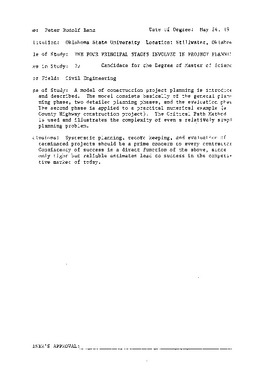| dc.contributor.author | Benz, Peter Rudolf | |
| dc.date.accessioned | 2016-01-14T21:49:01Z | |
| dc.date.available | 2016-01-14T21:49:01Z | |
| dc.date.issued | 1970-05 | |
| dc.identifier.uri | https://hdl.handle.net/11244/25603 | |
| dc.description.abstract | Scope of Study: A model of construction project planni.ng is introduce and described. The model consists basically of the general planning phase, two detailed planning phases, and the evaluation phase The second phase is applied to a practical numerical example (a County Highway construction project), The Critical Path Method is used and illustrates the complexity of even a relatively simple planning problem. | |
| dc.description.abstract | Conclusions: Systematic planning, record keeping, and evaluation of terminated projects should be a prime concern to every contraction Consistency of success is a direct function of the above, since only tight but reliable estimates lead to success in the competitive market of today. | |
| dc.format | application/pdf | |
| dc.language | en_US | |
| dc.rights | Copyright is held by the author who has granted the Oklahoma State University Library the non-exclusive right to share this material in its institutional repository. Contact Digital Library Services at lib-dls@okstate.edu or 405-744-9161 for the permission policy on the use, reproduction or distribution of this material. | |
| dc.title | Four principal stages involved in project planning | |
| osu.filename | Thesis-1970R-B479f.pdf | |
| osu.accesstype | Open Access | |
| dc.type.genre | Master's Report | |
| dc.type.material | Text | |
| thesis.degree.discipline | Civil Engineering | |
| thesis.degree.grantor | Oklahoma State University | |
